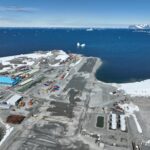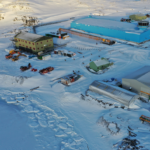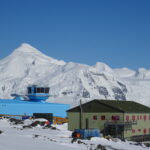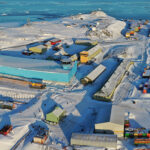The Antarctic Estate comprises a series of buildings and infrastructure some of which dates back to the 1970s and 1980s. The Antarctic Infrastructure Modernisation Programme (AIMP) will deliver critical new and updated buildings and a new energy infrastructure including renewable energy generation and smart energy systems.
When delivering a programme of major construction projects, the programme’s impacts on environment, the Antarctic community, and ability to deliver the British Antarctic Survey (BAS) science programme has to be carefully considered. The AIMP has a robust approach to sustainability that comprises:
- protecting both the unique local ecosystem in Antarctica and limiting its wider global impacts from its supply chain,
- supporting the community of scientists and field operatives,
- ensuring that BAS science and operations continues uninterrupted.
BAS responsibility includes changing the way the organisation operates and has strategic targets to meet with regards to climate change impacts.
BAS as an organisation has committed to achieve Net Zero from our directly owned operations by 2040*** and Rothera research station aims to decarbonise its operational activity by 2030. The AIMP is supporting these targets by incorporating the carbon targets in a wider sustainability strategy.
*** Aligned with the net zero commitments of the Natural Environment Research Council (NERC) and UK Research and Innovation (UKRI)
The AIMP Sustainability Strategy comprises eight major sustainability themes. The strategy was designed using the UN Sustainable Development Goals as a framework to understand what opportunities are present within the AIMP which could be maximised and what impacts are to be managed.
All individual projects must demonstrate their contribution to each of the strategy’s aims and objectives.

Create and maintain healthy working areas
Develop and maintain inclusive, safe, resilient and sustainable BAS Antarctic communities
Prioritise action to combat climate change and its impacts
Interact sustainably with the Antarctic environment
Create an efficient, reliable and sustainable Antarctic energy network
Maintain an efficient and sustainable water and wastewater regime
Ensure resilient facilities through sustainable and appropriately innovative design
Ensure responsible sourcing and efficient use of all resources through sustainable design and procurement
To track AIMP progress on the strategic aims, every project develops a Sustainability Management Plan (SMP) which tracks the project team’s decision-making.
There are additional sustainability processes embedded within the SMP to further support decision-making at project, programme and at organisational level:
Managing carbon
Projects are following the voluntary standard PAS 2080 Carbon Management in Infrastructure which requires regular in-depth operational and embodied carbon reporting. Reporting happens at every design and construction work stage and must include quantification, behaviour change, data sharing across the value chain and carbon governance. It also supports better carbon leadership from across the entire value chain including asset owners, designers, constructers and product suppliers in order to reduce carbon impacts.
Managing climate change adaptation
Climate change in Antarctica is an area which is being studied carefully by BAS scientists and the AIMP applies the knowledge to the design of BAS’ future assets. Climate change presents risks to Antarctic buildings and the people that live and work in them which AIMP designers need to identify and manage through design mitigation measures. As the climate changes, such as Antarctica experiencing more precipitation, BAS assets need to respond and adapt accordingly to maintain their longevity and provide suitable spaces for the Antarctic community across the estate.
Managing materials
Bringing materials to the Antarctic Estate and back is costly, requires complex logistics planning and storage options are limited. As such, there is a significant incentive to minimise materials use, maximise reuse on station, and reduce waste as much as possible. All projects will use a Materials Management Plan which implements the waste hierarchy, aims to increase the circularity of materials across the Antarctic Estate and improves sustainable procurement in the AIMP supply chain.
Managing environmental impacts
To comply with the Protocol on Environmental Protection to the Antarctic Treaty (1998) and the Antarctic Act (1994), all activities undertaken in Antarctica must complete an environmental impact assessment (EIA). Depending on the scale of activities, AIMP projects develop a Preliminary Environmental Assessment (PEA), an Initial Environmental Evaluation (IEE) or a Comprehensive Environmental Evaluation (CEE). These evaluations assess the potential impacts of proposed construction activities and identify alternatives to avoid, minimise or mitigate those impacts. The EIA documents are submitted to the Foreign, Commonwealth and Development Office (FCDO), the regulatory authority, for approval. The EIAs are undertaken at a stage when the impacts of design and construction are known and certain, whilst SMPs are developed at earlier work stages where design options are still being developed.
Accrediting performance
To give further assurance on AIMP sustainability performance, all projects will target BREEAM. BREEAM is a sustainability assessment method for buildings and infrastructure developed and managed by the Building Research Establishment (BRE). Projects which can evidence their sustainability credentials through the BREEAM credit system are awarded a ranking. All projects are targeting BREEAM Excellent as a minimum.
Further work on other sustainability issues such as a strategic sustainability appraisal, sustainability assurance, post occupancy evaluation, innovation, responsible procurement and integration of data with AIMP Building Information Management (BIM) is planned in the near future.
Sustainability principles are a major influence on how AIMP projects are developed. As AIMP project teams deliver on sustainability targets and commitments in the design and construction of the future assets, the extent of the AIMP’s benefits and impacts is constantly reviewed and improved through BAS governance structures and executive decision makers.

AIMP Trainee Sustainability Advisor
Industry project delivery partners
Our in-house project management works closely with external partners to deliver the sustainability aspects of modernisation projects at BAS Antarctic research stations.
- Emma Jones, Director (Sustainability), Ramboll
- Neil Goulding, Senior Site Environmental Manager, BAM Nuttall
- Tony McGlory, Director, Ramboll
- David Jackson, Senior Carbon Consultant, Sweco
- Sarah Joliffe, Environmental Sustainability Business Partner, BAM UK&I
2 April, 2024 by Katie Handford
As the Antarctic winter season fast approaches, we’ll be following the journey of one of the Antarctic Infrastructure Modernisation Programme’s (AIMP) Assistant Project Managers, Katie Handford as she gears up to spend winter at Rothera Research Station in Antarctica.
10 July, 2024
Construction teams have completed significant stages of the British Antarctic Survey’s (BAS) Antarctic Infrastructure Modernisation Programme and joined the over-wintering staff for the first time as the 2023/24 summer season ended. The improvements, led by BAM and technical advisors Ramboll will transform future science and operations at Rothera, the UK’s largest polar research station in Antarctica.
27 November, 2023
Construction has begun in Antarctica for the British Antarctic Survey (BAS) with specialists arriving at Rothera Research Station to progress several projects to secure the future of polar operations and …
The largest British Antarctic facility is a centre for biological research and a hub for supporting deep-field science.




